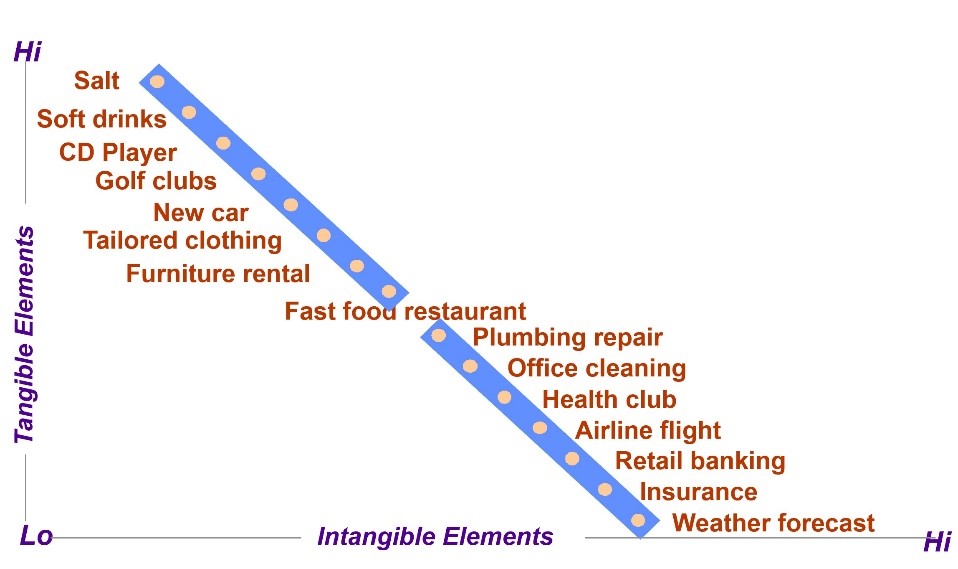
Exporting services can be an entirely different process than exporting goods. That’s why distinguishing between the two and classifying your business correctly is very important. It affects everything from crossing the border to improving your business.
In any discussion of international services, we need to start with some background. First, we will set aside the “international” portion for a moment to allow us to focus on service business generally. We begin with the difference between goods and services. A typical good is a manufactured product such as a smart phone. A typical service is not manufactured, like a haircut. We’ll see in upcoming posts a child’s haircut can provide an even better example of a service.
Drop It On Your Foot
One well-worn shortcut to discover whether a business is selling goods or services is the “Drop It On Your Foot” Test. If you can drop the product on your foot, that product is most likely a good. If not, it is most likely a service. This is because goods are often said to be tangible. They are material. They have volume, weight, and other observable traits. Services, on the other hand, are said to be intangible. Services are, in various ways, non-material. Services may have atmosphere, performance, attitude, opinions, etc.
As we prepare to administer the Drop on Foot Test safely, we can ask a hair stylist, “Just so this does not break my foot, how much does your haircut weigh?” The stylist will look at us with consternation because we are talking nonsense. By extension, we would be talking more nonsense if we try to compare goods and services by weight. Asking which is heavier, an overnight stay in a hotel or a coffee cup is ludicrous.

The coffee cup in the above example raises a thought. Let’s say a barista makes us some lattes. They create a performance. We can watch them. Some baristas are quite innovative in their performances. But you point out that each cup now has artwork in its foam – that is tangible. And the lattes each contain about a quarter liter of water. That weighs 0.25 kg and if that water is quite hot, we do not want to drop them on our feet! That’s a lot of tangibility, although we cannot weigh the barista’s performance.
This leads us to another consideration in selling services. We come to realize that each service business has a blend of “intangible elements.” Some businesses are dominated by their intangible elements, some businesses are very nearly selling goods. The more components of the final delivery that are tangible and material, the closer the business is to selling a good. Restaurants are a prime example. However, restaurants have varying degrees of “atmosphere.” Indeed, five-star restaurants have “much more” atmosphere than fast-food restaurants who in turn have more than vending machines. We can feel the atmosphere when we enter the five-star premises, but we probably should not ask the maître d’ how many grams of atmosphere they used on tonight’s 24-ounce porterhouse steak!
The Goods-Services Continuum
Lynn Shostack has developed a scale known as Goods-Services Continuum. We can see that a commodity like salt, sought by people since before recorded history, is probably the most tangible product. It is material and will remain so, even though it is a food product. It does not spoil. At the other end of the scale we see weather forecasting, a technology which we all will likely agree is still under development, is perhaps the least tangible product. After receiving a weather forecast, we have… nothing much, especially 24 hours later.
 At this point, we need to make an important distinction between goods and services. We sometimes hear that “In today’s business world, every firm is a service firm!” We know all businesses that provide customer service will be judged by the quality of their customer service. But here is the distinction: customer service, or after-sales service, are not the same as the service products created by services businesses.
At this point, we need to make an important distinction between goods and services. We sometimes hear that “In today’s business world, every firm is a service firm!” We know all businesses that provide customer service will be judged by the quality of their customer service. But here is the distinction: customer service, or after-sales service, are not the same as the service products created by services businesses.
The academic business literature has made this distinction for the past 25 years with the aim to help both kinds of businesses. Studying services will help goods businesses isolate the elements of their business that are service-oriented and improve them. On the other side, service business owners can use this distinction to explore their entire operation: operations, people management, and especially marketing. As we will see in upcoming posts, many of these business processes are conducted differently in a services business.
Crossing The Border

Finally, we can now tie intangibility into international services. Intangibility makes crossing a border with a service different than a good. A service’s intangibility means both customers and border agencies cannot see it, weigh it, examine it. In future posts, we will look at how customers acquire international services. But we can say right now that border agencies adjust their protocols accordingly, creating special rules for service people entering their countries. Each country’s rules create mobility barriers. A mobility barrier stops the free passage of people across international boundaries and include visas, work papers, and other documents that must be filled out correctly. But here’s something working in the favour of service businesses – if we choose our international markets carefully, we may be able to take advantage of free trade agreements to keep mobility barriers to a minimum PLUS provide a means to report incidents where unexpected barriers were imposed.
In this first post, we have covered the difference between goods and services. This led us into the concept of the “Drop It On Your Foot” Test that helps us get a grasp on tangibility and intangibility. We saw that all services businesses have varying amounts of intangible elements that make up their service products.
Stay tuned for the next blog post in our export services series, where we will look at more differences between goods and services that can impact services delivery at home or abroad.

 By Tim Thomas
By Tim Thomas

